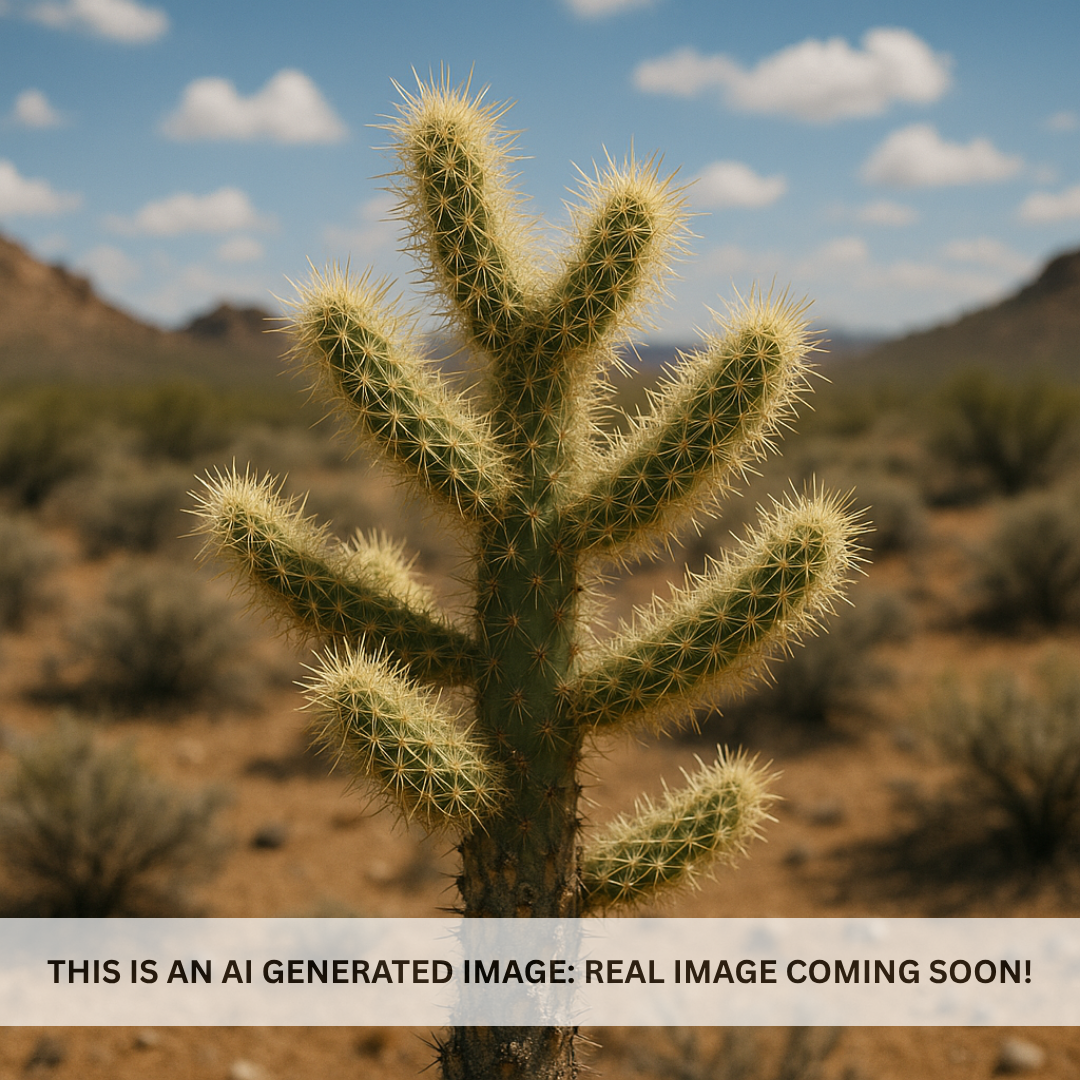My Store
Jumping Cholla
Jumping Cholla
Couldn't load pickup availability
Plant Type: perennial, cactus
Plant Height: 8–12 feet (can reach 15 feet in ideal conditions)
Spread: 6–10 feet
Flower Color: pink to magenta with bronze highlights
Sun Exposure: Full sun
Jumping Cholla (Cylindropuntia fulgida): The Iconic Desert Guardian with a Flash of Color
The Jumping Cholla (Cylindropuntia fulgida), sometimes called the Chain Fruit Cholla, is one of the most iconic cacti of the Sonoran Desert. Towering and dramatic, it’s known for its dense, spiny branches that shimmer in the sun—and for the way its segmented joints easily detach and “jump” when brushed against, a clever natural mechanism for propagation. Despite its fierce reputation, the Jumping Cholla is a spectacular structural plant that adds unmatched desert character to Arizona landscapes, with glowing pink-magenta blooms and a halo of silver spines that glint in the light.
Key Features of Cylindropuntia fulgida
The Jumping Cholla forms a tree-like structure with a central trunk and multiple upward-curving branches. Each cylindrical stem is covered in overlapping sheaths of silvery spines that catch sunlight, making the cactus appear almost radiant. The spines are barbed and detach easily—hence the “jumping” nickname—but they serve an ecological purpose, helping the plant spread by rooting new segments where they fall.
In late spring to early summer, Cylindropuntia fulgida blooms with clusters of pink to magenta flowers tipped in bronze tones. These blossoms are followed by distinctive hanging chains of pear-shaped fruit, which can persist for years, adding both weight and visual intrigue to the plant’s silhouette. The contrast of bright spines, colorful blooms, and cascading fruit makes it one of the most dynamic desert species in Arizona.
Though visually commanding, the Jumping Cholla is surprisingly low-maintenance once established, thriving in harsh, arid environments with minimal water or care.
Growing and Care Tips
The Jumping Cholla thrives in full sun and requires extremely well-drained, sandy, or rocky soil. It prefers open, dry locations with excellent airflow and plenty of space to spread.
During establishment, water every 2–3 weeks in warm months, allowing the soil to dry fully between cycles. Once established, it typically requires no supplemental irrigation except during extended drought. Overwatering or compacted soil will quickly lead to rot.
This cactus is highly heat-tolerant and can withstand Arizona’s summer extremes with ease. It is also frost-hardy down to about 20°F, making it ideal for most Valley landscapes. Avoid planting near walkways or high-traffic areas, as the barbed spines can easily attach to clothing, pets, or skin.
Pruning should be done cautiously with long tongs and thick gloves to remove lower or wayward segments. Each cut piece can root, so unwanted sections should be disposed of carefully.
Landscaping Uses
Cyclindropuntia fulgida brings drama, height, and authentic desert character to any xeriscape or naturalistic design. Its glowing spines and sculptural branching make it a perfect focal plant or backdrop for desert gardens, pairing beautifully with contrasting textures such as Ocotillo, Agave americana, Barrel Cactus, and Desert Spoon.
Because of its impressive size and potential for propagation, it’s best suited for large properties, desert parks, or low-maintenance landscapes where it can be admired from a safe distance.
In design, the Jumping Cholla captures the essence of the untamed Sonoran Desert—wild, enduring, and stunningly beautiful when viewed against the open sky.
Summary
The Jumping Cholla (Cylindropuntia fulgida) is a desert marvel—both formidable and breathtaking. With its silver spines, magenta blooms, and cascading fruit chains, it delivers year-round texture and drama to Arizona landscapes. A true survivor, it requires almost no care once established, serving as a bold reminder of the desert’s strength and resilience.
Three Timbers Installation Guide (Feel Free to Follow)
Cylindropuntia fulgida Planting Guide
Location: Full sun, open exposure, and plenty of space—avoid paths, entryways, or play areas. Ideal for desert landscapes and natural washes.
Soil: Extremely well-draining sandy or rocky soil. Avoid clay-heavy or compacted areas. Raised mounds or slopes improve drainage and mimic native desert conditions.
Spacing: Space 8–10 feet apart to accommodate full mature spread and reduce risk of contact with spines.
Planting Depth: Position the base of the trunk level with the surrounding soil. Avoid burying stem joints or covering with mulch.
Support: None required; trunk and branches are self-supporting once roots establish.
Watering Guide
Watering After Planting: Water deeply once immediately after planting to settle the soil. Allow the soil to dry completely before watering again.
When is the Plant Established? The Jumping Cholla is considered established after approximately 6–9 months, once new growth or fruiting chains appear and the trunk feels stable.
Watering Once Established: Water only during extended droughts or exceptionally dry seasons—typically once every 6–8 weeks in summer, or not at all in winter.
Drip Irrigation Setup: If using drip irrigation, place one low-flow emitter (0.5 gallon per hour) about 8–10 inches from the trunk base. Run infrequently and allow soil to dry completely before rewatering.
General Watering Tips: Avoid watering near the base too often; this species thrives in dryness. Do not use overhead irrigation, as retained moisture between spines can promote rot. Decorative gravel or native decomposed granite can be used as mulch but should be kept a few inches away from the trunk to ensure airflow.
Share














